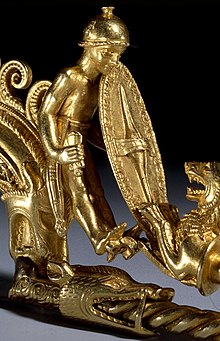
Back Cultura dels castres Catalan Castro (kultura) Czech Castrokultur German Kultura kastrumo Esperanto Cultura castreña Spanish Kastroen kultura Basque فرهنگ کاسترو Persian Culture des castros French Cultura castrexa Galician Castrocultura Italian


Castro culture (Galician: cultura castrexa, Portuguese: cultura castreja, Asturian: cultura castriega, Spanish: cultura castreña, meaning "culture of the hillforts") is the archaeological term for the material culture of the northwestern regions of the Iberian Peninsula (present-day northern and central Portugal together with the Spanish regions of Galicia, Asturias, and western León) from the end of the Bronze Age (c. 9th century BC) until it was subsumed by Roman culture (c. 1st century BC). It is the culture associated with the Gallaecians and Astures.
The most notable characteristics of this culture are its walled oppida and hillforts, known locally as castros, from Latin castrum 'castle', and the scarcity of visible burial practices, in spite of the frequent depositions of prestige items and goods, swords and other metallic riches in rocky outcrops, rivers and other aquatic contexts since the Atlantic Bronze Age.[1][2] This cultural area extended east to the Cares river and south into the lower Douro river valley.

The area of Ave Valley in Portugal was the core region of this culture, with many small Castro settlements, but also including larger oppida, the cividades (from Latin civitas 'city'), some known as citânias by archaeologists, due to their city-like structure: Cividade de Bagunte (Civitas Bogonti), Cividade de Terroso (Civitas Terroso), Citânia de Briteiros, and Citânia de Sanfins.[3]
- ^ Rodríguez-Corral, J. (2009): 13.
- ^ Comendador Rey, Beatriz. "Space and Memory at the Mouth of the River Alla (Galicia, Spain)" (PDF). Conceptualising Space and Place: On the role of agency, memory and identity in the construction of space from the Upper Palaeolithic to the Iron Age in Europe. Archaeopress. Retrieved 26 April 2011.
- ^ Armando Coelho Ferreira da Silva A Cultura Castreja no Noroeste de Portugal Museu Arqueológico da Citânia de Sanfins, 1986
© MMXXIII Rich X Search. We shall prevail. All rights reserved. Rich X Search